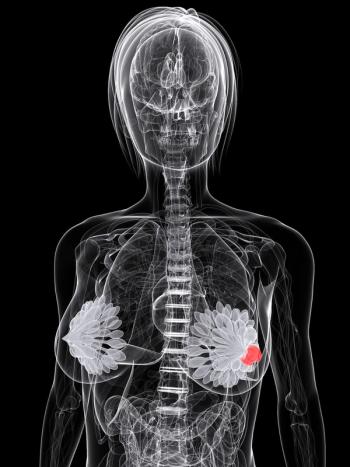
ENGOT-OV16/NOVA Study Results Continue to Support Niraparib Maintenance for Patients With gBRCA+/- Ovarian Cancer
PFS improvement as well as a trend to overall survival prolongation has been demonstrated with niraparib maintenance in patients with platinum-sensitive recurrent ovarian cancer with or without germline BRCA mutations.
Patients with platinum-sensitive recurrent ovarian cancer with or without germline BRCA mutations (gBRCAm) treated with niraparib (Zejula) in the ENGOT-OV16/NOVA study (NCT01847274) had clinical benefit persisting after first progression, according to data presented during the Society of Gynecological Oncology (SGO) 2021 Virtual Annual Meeting on Women’s Cancer.
According to the presenter, Ursula Matulonis, MD, although the study was not powered to evaluate overall survival (OS), a trend toward OS improvement was observed in both patients with non gBRCAm and gBRCAm platinum-sensitive recurrent ovarian cancer with a 9.7-month increase in survival. Niraparib also demonstrated a good safety profile in the study with hematologic adverse events (AEs) having decreased after year 1.
NOVA was a randomized, double-blind, placebo-controlled phase 3 trial of niraparib given as maintenance treatment for patients with platinum-sensitive recurrent ovarian cancer. The study included a cohort of 203 patients whose tumors were positive for gBRCAm as well as a cohort of 350 patients with non gBRCAm disease. All patients were randomized 2:1 to receive either niraparib 300 mg once daily or matching placebo. On treatment with niraparib, patients were assessed for the primary end point of progression-free survival (PFS), and secondary end points of safety and PFS2 (PFS after next line of treatment).
Niraparib led to a median PFS of 21.0 months in the 138 patients with gBRCAm platinum-sensitive recurrent ovarian cancer compared with only 5.5 months for the 65 patients given a placebo (HR, 0.27; 95% CI, 0.17-0.41; P <.001). In the non gBRCAm cohort of 234 patients, the median PFS was 9.3 months compared with 3.9 months for the 116 patients who received placebo (HR, 0.45; 95% CI, 0.34-0.61; P <.001).
Following the primary results of the NOVA trial in 2016, there was a high number of patient withdrawals from the study. Also, participation in the study was affected by the commercialization of other PARP inhibitors.
“Since 2014, approvals of PARP inhibitors worldwide in different lines of ovarian cancer therapy have revolutionized the treatment of women with ovarian cancer. During the time from the initial results of the NOVA study in 2016 to this final analysis, PARP inhibitors have become commercially available globally, ” Matulonis, chief of the Division of Gynecologic Oncology, Brock-Wilson Family chair, and institute physician at the Dana-Farber Cancer Institute as well as a professor of Medicine at Harvard Medical School, said during the SGO Annual Meeting presentation. “This availability of PARP inhibitors led to premature unblinding and withdrawals of treatment for patients in the NOVA study and led to missing data,” she continued. ,
Of the 138 patients with gBRCAm ovarian cancer who received niraparib, 110 discontinued treatment in the study. Of those who discontinued, 20 withdrew consent, 6 were lost to follow-up, 69 patients died, and 15 discontinued for other reasons. In the placebo arm of 65 patients, there were 56 discontinuations which included 11 withdrawals of consent, 2 patients lost to follow up, 28 deaths, and 15 discontinued for other reasons.
Among the 234 patients without a gBRCAm who were assigned to niraparib, there were 198 discontinuations of study treatment. Twenty-nine patients withdrew consent, 4 patients were lost to follow up, there were 145 deaths, and 20 patients discontinued for other reasons. In the 116-patient placebo cohort, 97 patients discontinued treatment. Reasons for discontinuation included the withdrawal of consent for 14 patients, 1 patient lost to follow up, 64 deaths, and 18 patients discontinued for other reasons.
At data cutoff, 28 patients with gBRCAm platinum-sensitive recurrent ovarian cancer were still receiving niraparib and 9 were still receiving placebo. Among the group of patients with non-gBRCAm platinum-sensitive recurrent ovarian cancer, 36 were still receiving niraparib and 19 were still receiving placebo at data cutoff. By final data lock, survival status could not be retrieved for 49% (76/155) patients.
Although crossover was not permitted in the NOVA study, the protocol allowed for patients to received subsequent PARP inhibitor therapy upon disease progression or withdrawal from the study. The high rate of discontinuations in the study left missing data for 25% of the study population. Matulonis noted that these missing data were challenging for survival analyses and interpretation. The protocol was therefore adjusted accordingly to assess for subsequent PARP inhibitor use for the small proportion of patients for which data were available.
With an 81% PFS2 maturity, patients with non-gBRCAm disease showed benefit on treatment with niraparib beyond the first progression (HR, 0.81; 95% CI, 0.632-1.050). The patients with gBRCAm disease had a 78% maturity (HR, 0.67; 95% CI, 0.479-0.948).
At an average follow-up of 5.6 years, OS data in the non-gBRCAm cohort were 68% mature and showed a median OS of 31.1 months with niraparib compared with 36.5 months with placebo (HR, 1.10; 95% CI, 0.831-1.459). After adjusting for subsequent PARP inhibitor therapy, the inverse probability of censoring weighting adjustment (IPCW) for median OS was 31.3 months with niraparib versus 35.9 months with placebo (HR, 0.95; 95% CI, 0.74-1.26). Matulonis et al, therefore, noted no difference in OS with niraparib compared with subsequent PARP inhibition.
For patients with gBRCAm disease, OS data were measured at63% maturity. OS was improved with niraparib at a median of 43.6 months versus 41.6 months with placebo (HR, 0.93; 95% CI, 0.633-1.355). After the IPCW, the median OS was 43.8 months with niraparib (95% CI, 36.4-56.2) compared with 34.1 months (95% CI, 27.6-53.0) with placebo (HR, 0.66; 95% CI, 0.44-0.99).
Long-term safety data for niraparib versus placebo in all study subjects showed that hematologic treatment-emergent AEs (TEAEs) mostly occurred within the first year of therapy. Overall, the most common TEAEs observed with niraparib were thrombocytopenia (35.7%), anemia (27.0%), and neutropenia (20.7%). In the placebo arm, the most common TEAEs were gastrointestinal disorders (5.0%), hypertension (2.2%), and neutropenia (1.7%). In the niraparib-treated patients, the incidence of grade 3 or higher thrombocytopenia decreased to 2.8% after year 1 or 2, and anemia and neutropenia decreased to 0.7% and 2.1%, respectively.
Overall, 49 patients remained on niraparib for more than 3 years compared with 9 patients in the placebo arm. Myelodysplastic syndrome (MDS) or acute myeloid leukemia (AML) was observed in 1.4% of patients in the niraparib arm compared with 1.1% in the placebo arm. Considering long-term treatment as well as the use of subsequent therapies, the incidence of MDS/AML was 3.5% with niraparib versus 1.7% with placebo.
“There was a higher risk of MDS or AML in the germline BRCA mutated group compared to the non-germline BRCA mutated group for both in the rapper and the placebo arm,” Matulonis noted.
Reference
Matulonis UA, Herrstedt J, Oza A, et al. Long-term safety and secondary efficacy endpoints in the ENGOT-OV16/NOVA phase 3 trial of niraparib in recurrent ovarian cancer. Presented at: Society of Gynecological Oncology 2021 Virtual Annual Meeting on Women’s Cancer; March 19-21, 2021; Virtual. Abstract 37.
Newsletter
Stay up to date on recent advances in the multidisciplinary approach to cancer.
















































































